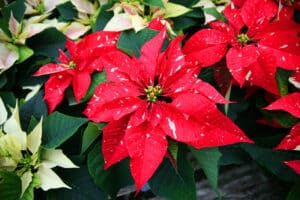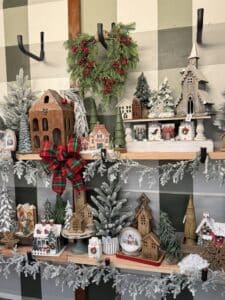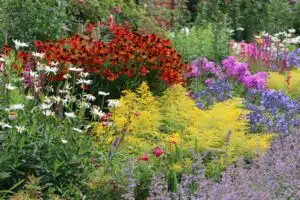A beautiful garden is a joy to behold, but many gardeners face the challenge of keeping their landscape looking vibrant and interesting throughout the year. While annuals provide bursts of seasonal color, perennials are the hardworking backbone of any great garden design. They offer lasting structure, texture, and a continuous cycle of blooms that bring your garden to life, even in the quieter months.
With the right perennial garden design, you can create a dynamic landscape that evolves with the seasons. This guide will walk you through the essential techniques for using perennials to build a garden that captures interest from the first spring thaw to the final winter frost. We’ll cover everything from layering plants to planning for seasonal color, giving you the tools to create a stunning, year-round display. At J&J Nursery and Garden Center, we offer a wide selection of perennials, and our knowledgeable staff is always available to provide advice and assistance.
Building Your Garden’s Foundation with Layering
A well-structured perennial garden uses a technique called layering to create depth and visual appeal. Think of it as painting a picture, using plants of different heights to fill the canvas. This approach ensures your garden looks full and intentional, rather than flat or sparse. A successful layered design includes three main levels:
Groundcover Plants
These low-growing perennials form the base layer of your garden. They are excellent for suppressing weeds, retaining soil moisture, and creating a lush carpet of foliage and flowers. Groundcovers soften the edges of pathways and fill in the gaps between taller plants.
- Creeping Thyme (Thymus serpyllum): A tough, drought-tolerant option that releases a lovely fragrance when walked on. It produces tiny purple or pink flowers in early summer.
- Ice Plant (Delosperma): Perfect for Utah’s sunny, dry conditions, this succulent groundcover offers dazzling, daisy-like flowers in vibrant colors throughout the summer.
Mid-Height Plants
The middle layer is where you can add bold splashes of color and interesting textures. These plants typically range from one to three feet in height and serve as the main focal point for much of the growing season. They bridge the gap between low-growing groundcovers and taller background plants.
- Coneflower (Echinacea): A classic, drought-resistant perennial that blooms from mid-summer into fall. Its sturdy stems and distinctive seed heads provide winter interest for both you and the birds.
- Salvia (Salvia nemorosa): Known for its vibrant spikes of purple, blue, or pink flowers, salvia is a magnet for pollinators and blooms for an extended period.
Tall Plants
Tall perennials create the backdrop of your garden, adding height, drama, and a sense of enclosure. These plants, which can grow over three feet tall, draw the eye upward and can be used to screen unwanted views or create a soft boundary.
- Hollyhock (Alcea rosea): With their towering stalks of large, colorful flowers, hollyhocks bring a charming, cottage-garden feel. They are perfect for planting against fences or walls.
- Russian Sage (Perovskia atriplicifolia): Its silvery foliage and airy, lavender-blue flower spikes provide fantastic texture and color from mid-summer through fall.
Designing for Continuous Interest
A truly exceptional perennial garden offers something new to see in every season. This requires thoughtful planning beyond just a few weeks of summer blooms.
Plan for Continuous Blooms
Select a variety of perennials that bloom at different times. Start with early spring bloomers like creeping phlox, move into summer with daisies and yarrow, and finish the season strong with asters and sedum in the fall. Creating a simple bloom chart can help you visualize when each plant will be at its peak, ensuring you never have a dull moment.
Don’t Forget Foliage and Texture
Flowers are fleeting, but foliage provides interest for months on end. Contrast is key. Pair the fine, feathery leaves of a fern with the broad, bold foliage of a hosta. Mix the silvery tones of lamb’s ear with the deep greens of a boxwood. This textural play adds a layer of sophistication to your perennial garden design, making it visually engaging even when nothing is in bloom. The seed heads of plants like coneflowers and the graceful blades of ornamental grasses also add wonderful structure in the fall and winter.
Maintaining Structure and Vigor
To keep your perennial garden looking its best year after year, regular maintenance is essential. Pruning and dividing not only keep plants healthy but also maintain the structure you’ve worked so hard to create.
- Pruning: Deadheading, or removing spent flowers, encourages many perennials to produce a second flush of blooms. In the fall, some gardeners prefer to leave the dried stems and seed heads standing for winter interest and to provide food for wildlife. Others cut perennials back to the ground after the first hard frost to keep the garden tidy.
- Dividing: Most perennials benefit from being divided every three to five years. This process involves digging up the plant, splitting the root ball into smaller sections, and replanting them. Dividing rejuvenates overgrown clumps, promotes better flowering, and is a great way to get more plants for your garden for free!
Start Your Perennial Garden Design Today
Creating a garden with year-round appeal is a rewarding project that brings lasting beauty to your home. By using layering techniques, planning for continuous color and texture, and performing regular maintenance, you can design a perennial garden that is a constant source of joy.
Ready to start building your dream garden? Contact us today to get started! We offer a wide variety of plants and expert advice to help you create the perfect perennial garden for your space.



